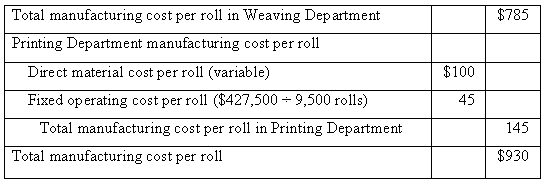Quality improvement, theory of constraints. The Wellesley Corporation makes printed cloth in two departments: Weaving and Printing.
Question:
Quality improvement, theory of constraints. The Wellesley Corporation makes printed cloth in two departments: Weaving and Printing. Direct material costs are Wellesley’s only variable costs. The demand for Wellesley’s cloth is very strong. Wellesley can sell whatever output quantities it produces at $1,250 per roll to a distributor who markets, distributes, and provides customer service for the product. Wellesley pro- vides the following information.

Wellesley can start only 10,000 rolls of cloth in the Weaving Department because of capacity constraints c the weaving machines. If the Weaving Department produces defective cloth, the cloth must be scrapped and yields zero net disposal value. Of the 10,000 rolls of cloth started in the Weaving Department, 500 (5%) defective rolls are produced. The cost of a defective roll, based on total (fixed and variable) manufacturing cost per roll incurred up to the end of the weaving operation, equals $785 per roll, as follows:

The good rolls from the Weaving Department (called gray cloth> are sent to the Printing Department. Of the 9,500 good rolls started at the printing operation, 950 (10%) defective rolls are produced and scrapped at zero net disposal value. The cost of a defective roll based on total (fixed and variable) manufacturing cost per unit incurred up to the end of the printing operation, equals $930 per roll, calculated as follows:

The Wellesley Corporation’s total monthly sales of printed cloth equal the Printing Department’s output. Each requirement refers only to the preceding data. There is no connection between the requirements.
1. The Printing Department is considering buying 5,000 additional rolls of gray cloth from an outside supplier at $900 per roll. The Printing Department manager is concerned that the cost of purchasing the gray cloth is much higher than Wellesley’s cost of manufacturing it. The quality of the gray cloth acquired from the outside supplier is very similar to that manufactured in-house. The Printing Department expects that 10% of the rolls obtained from the outside supplier will result in defective products. Should the Printing Department buy the gray cloth from the outside supplier? Show your calculations.
2. Wellesley’s engineers have developed a method that would lower the Printing Department’s rate of defective products to 6% at the printing operation. Implementing the new method would cost $350,000 per month. Should Wellesley implement the change? Show your calculations.
3. The design engineering team has proposed a modification that would lower the Weaving Department’s rate of detective products to 3%. The modification would cost the company $1 75,000 per month. Should Wellesley implement the change? Show your calculations.
CorporationA Corporation is a legal form of business that is separate from its owner. In other words, a corporation is a business or organization formed by a group of people, and its right and liabilities separate from those of the individuals involved. It may...
Step by Step Answer:

Cost Accounting A Managerial Emphasis
ISBN: 978-0136126638
13th Edition
Authors: Charles T. Horngren, Srikant M.Dater, George Foster, Madhav





